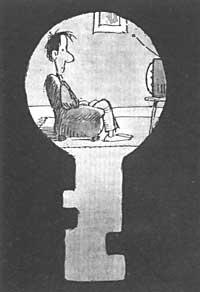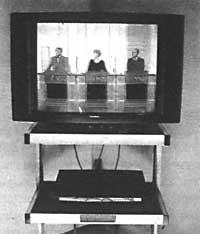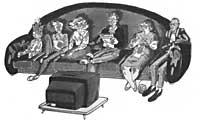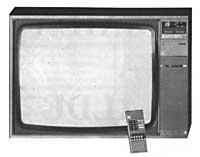Television and advertising
1990/07/01 Jauregi, Mariaje - Elhuyar Fundazioa Iturria: Elhuyar aldizkaria

In general, in this world there are five groups of actors of different interest, with different interests. These are the five groups:
- TV channels. These have a lot of interest in officially assigning the largest possible audience. It is a matter of fame, but also of money. Advertising is your source of income and depends on the public, as more publicity will be obtained.
- Advertisers. They use advertising to promote their products and improve their sales. They are willing to pay, but they want affordable prices, and that suitability, once again, has much to do with the measure of the public.
- Advertising agencies. They are intermediaries between advertisers and chains and defend the interests of their customers, their advertisers. These do not necessarily see bad surveys underestimate the public, since they are paid a percentage.
- Hearing measurement institutes. They sell audience figures to the network and television agencies and the competition is hard to defend that the most concrete figures are their own.
- Public. This is ultimately the goal. They all want to know their customs.
Competition area
Advertising claim
the budget of advertisers has been exaggerated much of what has become and the parts of the margin that form the money needed to market the product have changed a lot. To make an idea, about thirty years ago, when buying a bottle of mineral water 90% was paid for the same water, 5% for the bottle and 5% for the claim. Currently only 15% is for the product itself. The rest is for advertising that has become a global industry. Many millions are used in all media.
Parts of the cake formed by the media have also been modified. Among the different media that are offered to advertisers to reach the clientele, the written press continues to predominate. But television is appropriating space, because the desire to introduce advertising in that media is increasing. But what is the reason?
Advertising experts know perfectly well that TV spots do not have a much higher incidence than those of other media. As for the “memorization rate”, that is, the capacity of the receiver to remember the advertising message seen, the largest is achieved with cinema advertising (75% cinema, 20% television). The reason for this passion is the number. Despite the written press that sells more copies, the number of people watching a television broadcast will never be so large.
But while knowing the print run of a newspaper is easy, it is much more difficult (perhaps impossible) to know how many people watch television. This field includes competition between institutes that measure audience, trying to defend that the most accurate and reliable data are their own.

These institutes want to know the consumption of hertzian waves: Who sees TV, what function, what time, etc. That is, the public of that media. However, when defining this audience, problems arise, because what does the audience give, the number of TVs that are on? or the number of viewers in front of the screen? or just keep in mind those who are watching TV attentively?
Audience Measurement Teams
In this work of measuring the public different resources have been used. However, it must be said that there are no perfect systems or systems that satisfy everyone. Advertisers don't know exactly how many they see their spots. To know the behavior of the spectator it is necessary to go to representative samples of the population. However, great steps have been taken to know the customs of the television viewer.
In general, there are two methods: on the one hand, polling surveys (in which the public is asked to report on the actions they see regularly) and on the other, automatic detection procedures (boxes connected to television are placed). They record the data and transmit it at night through the telephone line to the computer station.
Generations of measures
Making a brief history of evolution in this field can differentiate about three generations of methods.
Before starting to appear advertising on the small screen, to know the public of the different programs a survey system was used by poll. The selected viewers received the performances and their opinions. They were collected every day, passed the information to punched cards and dealt with computer. To obtain the results it was necessary to wait at least a week.
The process was subsequently automated. In the homes were installed appliances that detected the chain in which the television was on or off. A box placed under television automatically supplied this data every morning by sending data by telephone to the central computer. This system was initially annoying. For example, when there was a storm they were altered and turned amnesicas. Later they improved a lot.

This automatic public measurement system was sufficient for those responsible for television programs. But not for advertising people. And it is that you could not know if the spot launched in those hours, nor how many people saw. To do this, the procedure was based on the technique connected to the automatic recording of the television operation was a significant advance. This system allows estimating the number of people watching television.
This technique involves placing a box with buttons under the TV. Each family member is assigned one of these buttons. Every time you start watching TV, you should press this key and perform a similar maneuver as you march.
This type of system is called “active” because the viewer is asked to do something. And here it is precisely the impediment of this method, since many times the viewer can forget to press the button or make a trapdoor.
To address this problem, an automatic “passive” system was developed that would constitute the third generation. With this current system the viewer does not have to do anything and is able to detect the number of people who are watching the performance through electronic eyes.
In this case a box is also placed next to the television. This intelligence box detects people in the room. It is the photonic procedure you use for this. Anything or being illuminated reflects a part of the light it receives and therefore becomes visible. To distinguish whether this object is alive or inert, this system analyzes changes in each light source.
To facilitate the search is usually a little short-sighted: more than four meters do not know what happens, but instead the close-up vision was tuned. Do not mix the house dog with the child. In addition, one more eye has been added so you can see it in semi-relief and do not confuse two people too close, for example. Moreover, it continuously sends infrared to the target so it is able to see it also in the dark.
As you can see, this system allows you to know all the customs of the spectator (that 30% of TVs work without anyone being present, that people abandon during advertising, etc. ). All collected data is accumulated, sent at night to the calculation centers over the network and processed by expert systems. The results can therefore be known in real time.
What will the future look like?

Much progress has been made in this field of audience measurement. The viewer no longer has to do anything and the mistakes he has caused have been overcome. But the system is not yet perfect. Without going into detail, we will say that these measurement methods are based on approximations that by chance can falsify figures.
In addition, it is easy to understand that many houses do not accept that role of rocket; they do not accept that box that controls you under television. And there is doubt. Whether or not those viewers who accept are representatives of the media, and whether the data extracted from it can be extrapolated to others.
On the other hand, what is clear is that if you want the data after measuring the public to be as accurate as possible, you have to rely on “passive” systems, on methods in which the viewer does not have a direct participation.
And the methods being studied to better understand our customs go precisely that way.
One of them is the hidden camera. It is based on the same technology used in military systems that allows missiles to distinguish between American and Soviet aircraft. It is based on knowing the physiological characteristics of each person, such as the arch of the eyelash or the ear.
In the United States, it is being studied the possibility of introducing miniaturized emitters in some object that spectators constantly carry out (watch or jewelry). The possibility of establishing emitters under the flea size skin is even being studied. Maybe that's the way.
It is, in short, to sell more tomato boats, dog food or life insurance
...
Gai honi buruzko eduki gehiago
Elhuyarrek garatutako teknologia




